As the sun begins to set on RK3326 powered devices, the GameForce handheld sets out to buck the trend of straight OGA clones with the inclusion of some cool features. It’s been a long time in the making, but the GameForce is finally here.
Rumblings of the GameForce first appeared back in July last year, and its creator Gao Feng has been active on the RG Handhelds discord server since then. The GameForce handheld is not made by a large established team like Anbernic or GPD, it’s mostly the vision of one man. This fact, along with the ongoing chip shortages go some way to explain why it took longer than expected to be released. I’ve had a retail unit for a couple of weeks now, so let’s have a look at it.
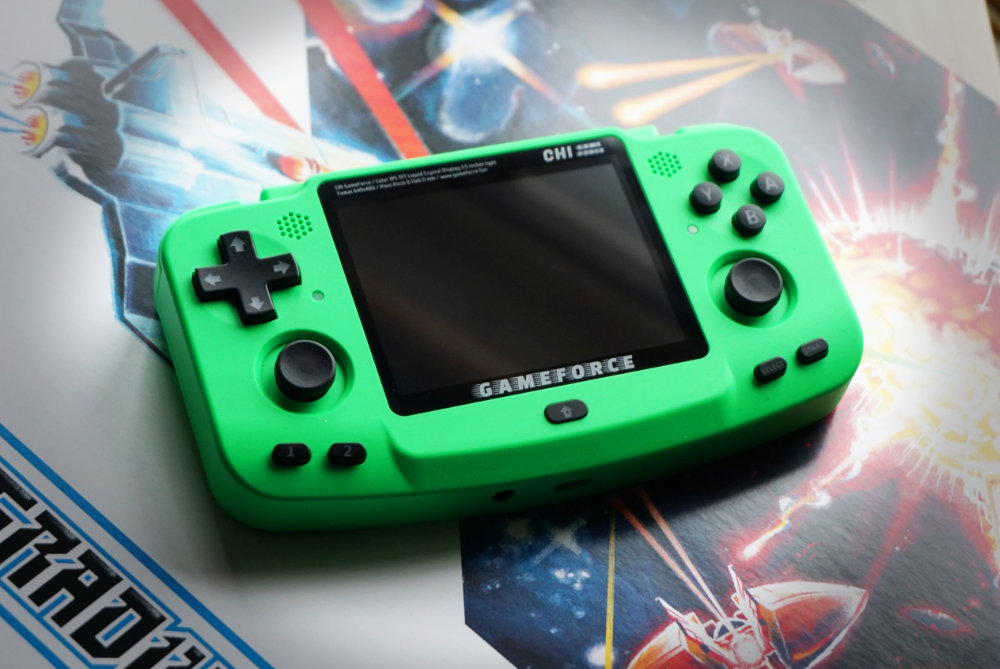
When the GameForce was first announced it attracted a lot of attention, not only because of its striking looks, but also because it was to be the first RK3326 device with a 4:3 ratio 640×480 display. When HardKernel released their Odroid-Go Advance, the easiest course of action for other manufacturers wanting to jump on the bandwagon was to mirror the hardware as closely as possible. HardKernel chose an unconventional screen ratio and resolution for the OGA, and all of the “cloned” devices followed suit. One of Gao Feng’s goals was to develop a device with a better suited display, bucking the trend for out and out hardware clones. Of course, Anbernic eventually beat him to it with their RG351V – but credit where credit is due, Gao was first to start work.
FEATURES
RGB
Aside from the choice of LCD, compared to many other RK3326 devices the GameForce handheld has some nice additions. For the first time in any handheld that I’m aware of, all of the controls are backlit with RGB LEDs. The stock OS has the ability to change the backlight colours, or to turn them off entirely. From what I gather, the backlights were more of a headache than anticipated to implement – but they’re there and they work.
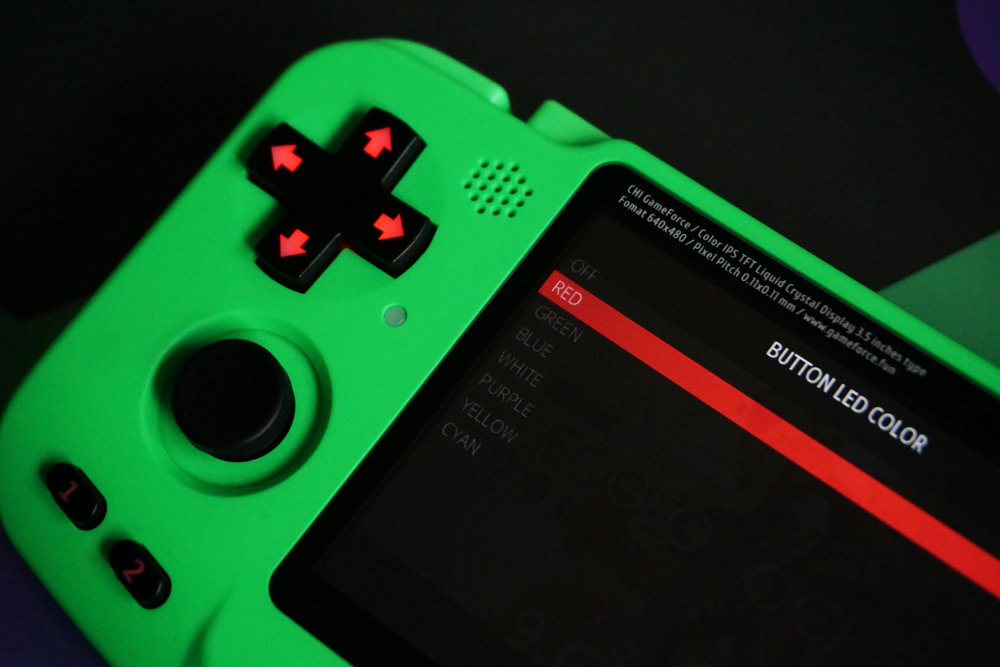
Depending on the colour of your device, some colours do bleed through the plastic. Red looks great on the green unit, whereas blue apparently works best on the milky coloured version. If it bothers you, some tape inside the shell would likely fix it.
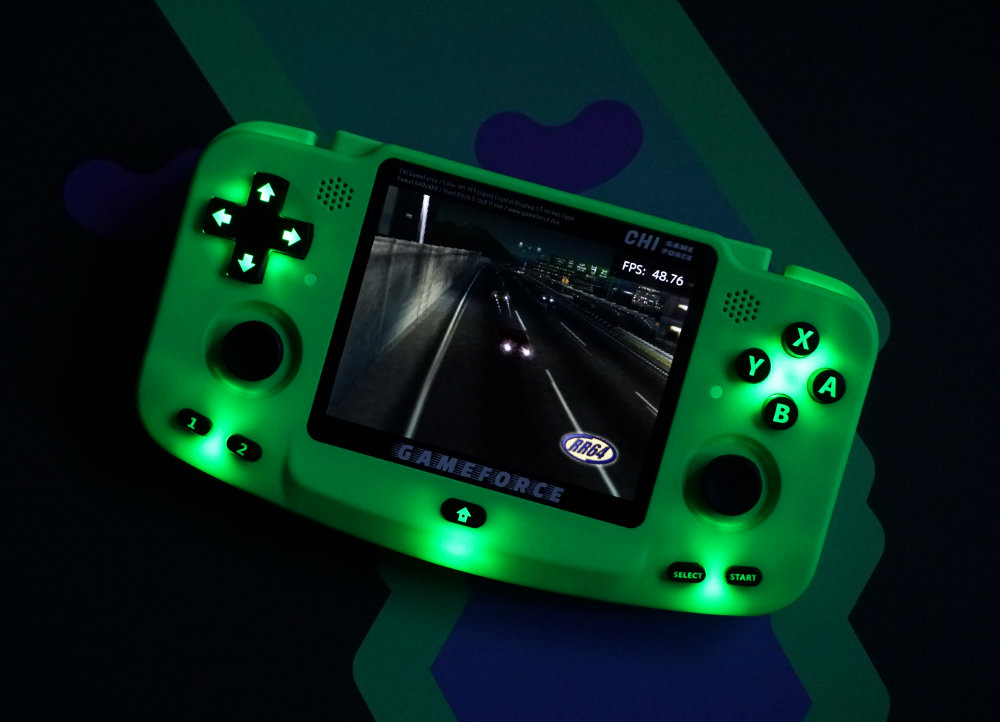
There is also an orange charge light bottom right of the d-pad and a status LED bottom left of ABXY. I’m not sure of the purpose of that status LED, and by default it flashes in “heartbeat” mode. The EmuELEC settings allow you to configure this to always on, heartbeat or always off.
WIFI / BLUETOOTH
The inclusion of working WiFi is also another welcome feature of the GameForce. Whilst it’s limited to 2.4Ghz networks only, it is stable and quick with a decent range. It doesn’t suffer from any of the interference issues that plagued some of Anbernic’s devices in the past either. The WiFi allows you to use Retro Achievements if you’re into that, and to easily transfer ROMs from your PC wirelessly via WinSCP or FileZilla. Just get your device connected to WiFi and use root/emuelec as the username and password for the SFTP connection. From there you can drag and drop to your heart’s content. The wireless chip inside the GameForce is also Bluetooth enabled, but as yet there isn’t a working driver for it. If this is implemented it should be possible to pair external controllers to the device for multi-player games.

SPEAKERS
The GameForce handheld has two front facing speakers placed each side of the LCD at the top. This placement makes more sense than on the back or the bottom, and in normal gaming conditions you would never accidentally cover them up. They’re not massively loud, but they’re loud enough and the sound quality is good for their size.
BATTERY
A 3000mAh battery provides between 3 and 4 hours gameplay depending on usage. The charge current does seem slow, but apparently the power management is the same on all RK3326 devices so maybe I’m just impatient. There are 2 rumble motors inside the GameForce, but I’m yet to find a game that actually supports them. It could be that the driver isn’t implemented, or maybe I’m choosing the wrong games.
STORAGE
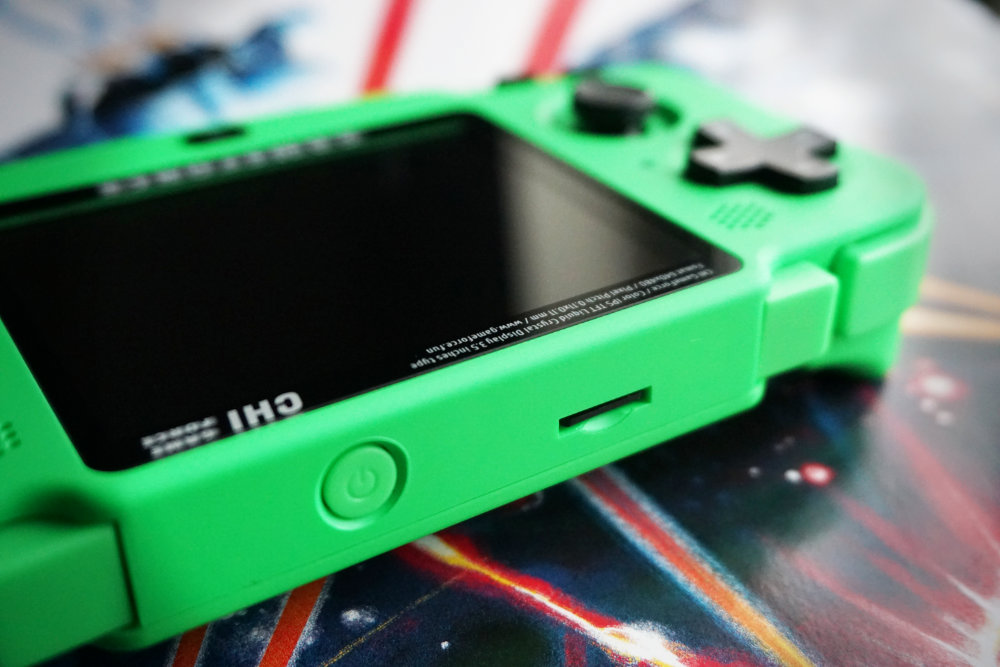
All storage is taken care of via a single microSD card. It’s worth noting that you’ll be supplying your own, as it doesn’t ship with one. I can see why they’ve gone this route, it seems that most people replace them for their own cards anyway. The GameForce can apparently support up to a 512GB card, but I don’t have one anywhere near that size.
EMUELEC OS
EmuELEC is the system of choice for the GameForce handheld, and another massive bonus for this device is that it has official support directly from EmuELEC dev shantigilbert. Shanti is the developer also supporting the Odroid-Go Advance, and if you check his github you will find builds made specifically for the GameForce now too. One of the biggest complaints with the Anbernic devices is the poorly implemented stock EmuELEC build, so to have official support for this handheld is a great benefit to us.
A dedicated home button sits bottom middle of the device, and provides an easily identifiable hotkey for a multitude of shortcuts within the OS. Used in combination with the Home button, these are the following shortcuts I have found.
- B = reset game
- X = retroarch settings
- D-pad u/d = volume
- D-pad l/r = change state slot
- R1 = save state
- R2 = fast forward
- 1 = load state
- 2 = toggle fps
- Start = quit
I should say that these shortcuts do different things when in the menus. Unfortunately, as far as I can tell both functions are triggered when you use the shortcuts in game. For example, Home+R1 is mute, but it is also save state. In game, Home+R1 will save state and mute the audio. Saving state again re-enables the audio. I’m not all that familiar with this OS, so it’s possible I got something set up wrong. If not then presumably it will be ironed out in good time.
Oh, the GameForce supports OTA updates too. I’ve used it once to update from the test version, and it worked a treat.
BUILD QUALITY
Manufacturers such as Anbernic and GPD are now creating devices that almost rival the likes of Nintendo in terms of build quality. But if you think back to some of their devices from a few of years ago (RG300, RS-97, GPD G5A for example), this is about the quality of manufacture that the Gao Feng has achieved with the GameForce. There’s nothing in particular that’s wrong with it, but it doesn’t quite have the same level of finesse that you might be used to.
To be clear, the device is solid and the plastic moulding boasts perfectly flush seams. There are some tell tale signs that this is Gao’s first device though – and that’s fine. For example the finish on my green unit is very matte. That’s great in some ways, because it’s almost impossible to leave a greasy marks on it. Nothing shows up, it actively rejects fingerprints. But on the other hand it feels kind of unusual, almost chalky to the touch. I’ve gotten used to it in the few weeks I’ve had it, but it’s something to be aware of.
CONTROLS
D-PAD
The d-pad has had a couple of revisions since the early prototype units were sent out. I never had one of those, so I can’t compare directly but it does feel different to Anbernic’s d-pad implementation. It’s not as stiff, and has a shallower pivot. It’s responsive, and hasn’t mis-fired on me but initially it took a little getting used to. The d-pad is a good size and is domed upwards towards each edge which makes it pretty comfy to use. Travel is just enough that it sits slightly proud of the case when pressed in any direction. It feels a little squishier than my preference, but overall it’s OK.
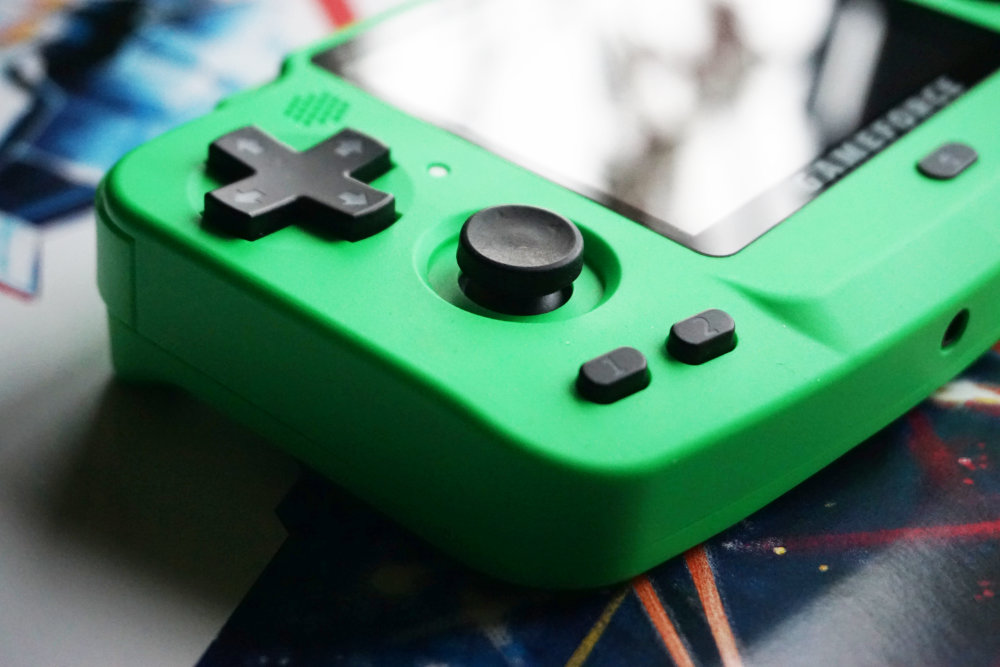
ANALOG STICKS
The analogs are generic ALPS branded sticks with slightly rubberised concave caps on them. They do the job and they’re nice and smooth, but physical range of movement could do with being a little wider. There’s no L3/R3 function on these sticks. It is possible to do a drop in replacement for PS Vita sticks, and Jutleys from rghandhelds.com has done just that on his unit (image). Personally I’m happy enough with the supplied analog sticks, but tinkerers might have some fun replacing them.
ABXY
ABXY buttons are smaller than we’re used to, and they protrude a little far from the shell for my taste. They’re OK but feel a bit mushy. They could do with being recessed about a millimetre further into the shell too. I haven’t had any problems with responsiveness from them. I would usually take this for granted, but some previous handhelds from other manufacturers have taught me not to.

SHOULDER BUTTONS
The shoulder buttons are some of the most comfortable I have ever used on a handheld. Shoulder buttons are usually the reason I get cramp, but these are set up perfectly. L1 and R1 can be reliably pushed anywhere from the rounded corners all the way to the inside edge, using the middle of your index finger. The tips of your fingers naturally rest on L2/R2, which are purposefully set around a millimetre higher than L1/R1. Overall the GameForce is really comfortable to play for extended periods, and we’ll talk more about that shortly.
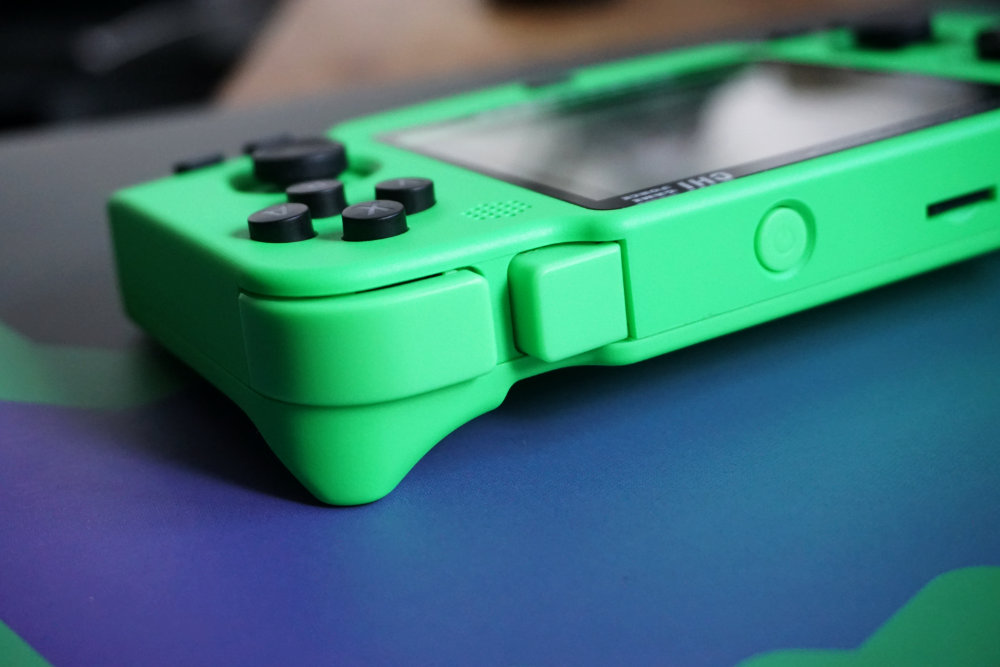
LCD
For me the LCD is the main reason to choose the GameForce handheld over most other RK3326 devices. The 4:3 aspect ratio is far more sensible for the majority of systems that it can emulate. It provides an almost full-screen integer scaled image for a large selection of systems. Whilst it’s not great for GBA, having a resolution of 640×480 looks much better than 320×240 on screens of the same size. There isn’t really a perfect solution to cater for every system, but in a device of this price I am convinced that 4:3 640×480 is the best choice.
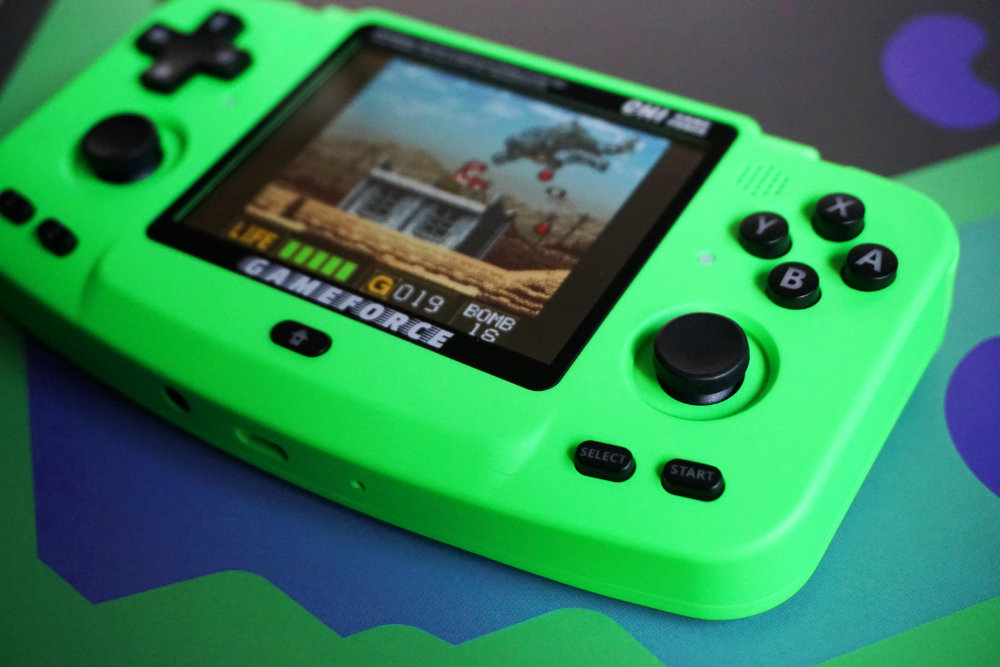
There is no OCA lamination on the GameForce handheld, and you can see that it is recessed a couple of millimetres below the glass lens. Clarity and viewing angles are excellent however, and the LCD itself is bright enough. There’s no noticeable light leak on this device either.
The text on the screen lens is intentionally made to resemble that of the Neo Geo Pocket Color. A conscious decision based on the designers love for the system. I like it, but I know some people get distracted by text bezels. I always found it puzzling that so many people hated the orange Anbernic logo on the RG350.
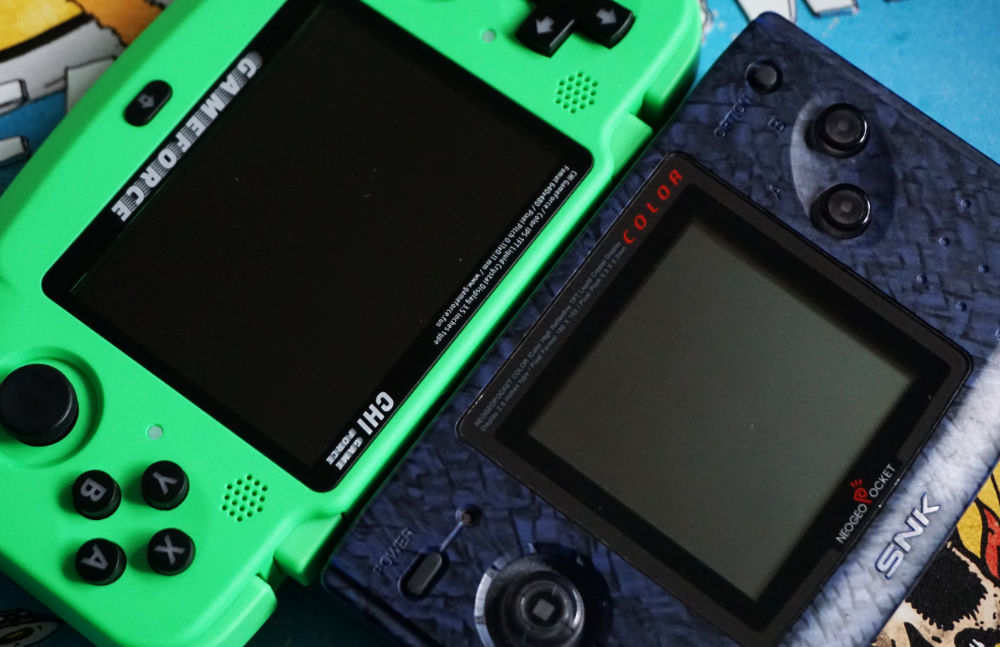
DESIGN
Brash and ugly to some, pleasingly chunky and nostalgic looking to others, opinions on its design are certainly polarised. I find it fondly reminiscent of the NGPC and GBA era, so you can put me in the latter camp.
The GameForce design is big, chunky and has a decidedly early 2000s aesthetic. It comes in a choice of two unashamedly bright colours, and a “milky” version too if you’re into that. I must admit I do think a black one might have been a good idea. Whilst some of its competitors take a more serious approach to their design, there is something to be said for the playful and cartoon-like look of the GameForce.
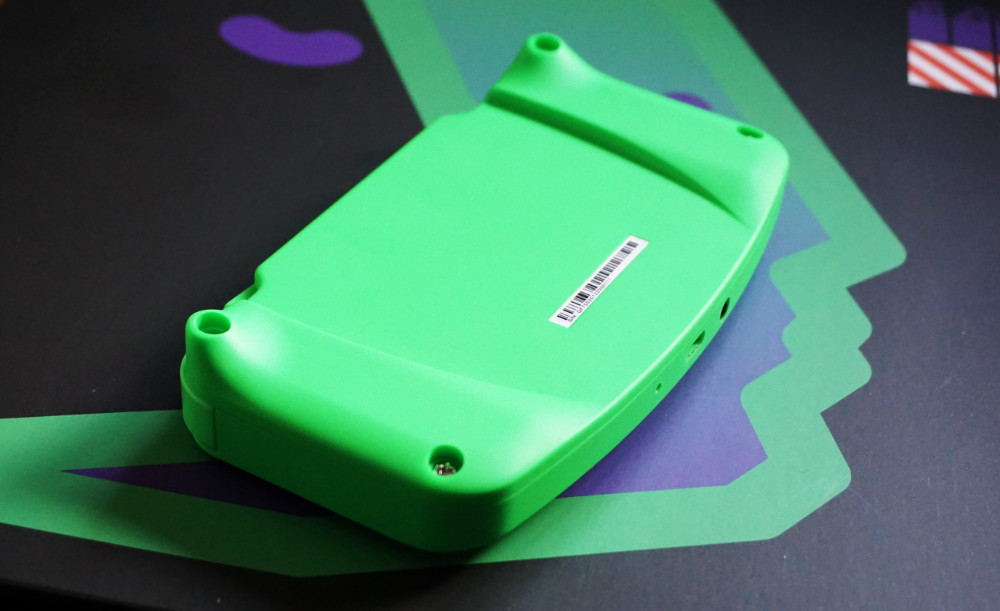
The unusual “nipples” on the bottom provide a super comfortable resting place for your middle finger. Those nipples were a bold design choice, and have been called out for looking silly. But there’s a reason they’re there and that’s long term comfort. For me there hasn’t been a handheld as comfortable to play for prolonged periods of time since the GPD G5A. Whether you love or hate the design, you won’t hate your hands after a couple of hours of game play. I do think some rubber bungs to fill those holes might have made it look less odd mind you.
WRAP UP
The RK3326 made it’s way into affordable handhelds at the beginning of 2020, and since then there have been bloody loads of them. The best of the bunch prior to the GameForce all lack at least one thing that the GameForce has got. Working WiFi, a sensible LCD, dual analog sticks and official EmuELEC support. The RG351V is the closest competitor in this group, and if you’re after a RK3326 powered handheld today my choice would definitely be either that or the GameForce. If dual analogs and official support is important to you, it’s the GameForce.
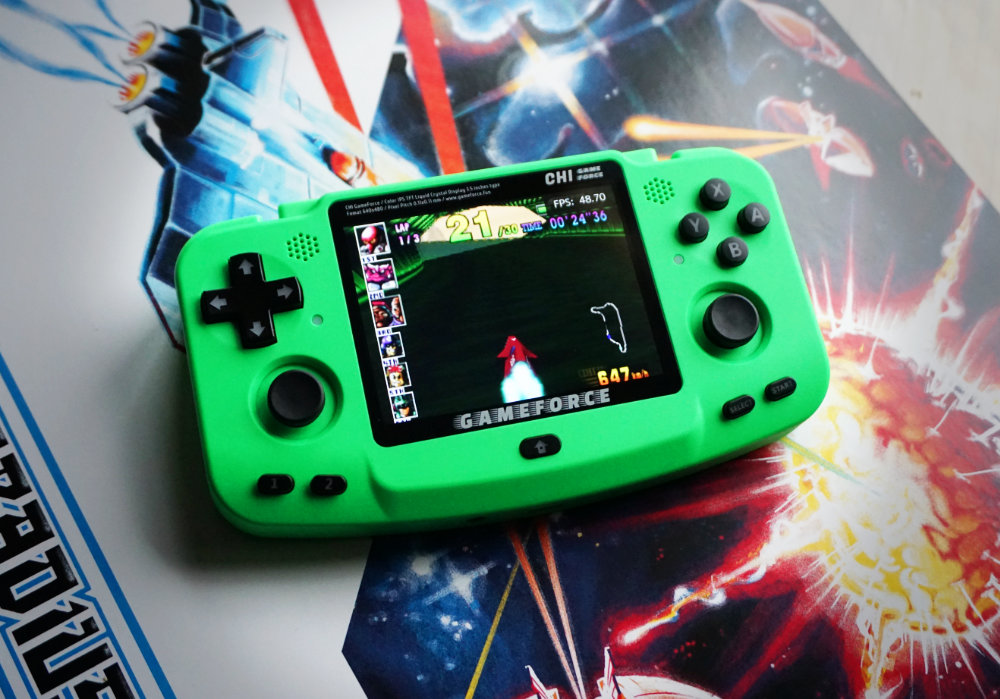
We might be on the cusp of more powerful handhelds entering the market, but right now the GameForce handheld is a very decent choice if you can look past the slightly less than perfect execution and throwback design. My unit was sent to me free for review by the folks at gameforce.fun. You can purchase the GameForce at the affiliated link below for $95 plus postage right now.
If you’re interested, you can use the code OBSCURE to get a few dollars off.
The above link helps the upkeep of this site. This link supports the EmuELEC devs instead, and helps fund continued development of the OS.

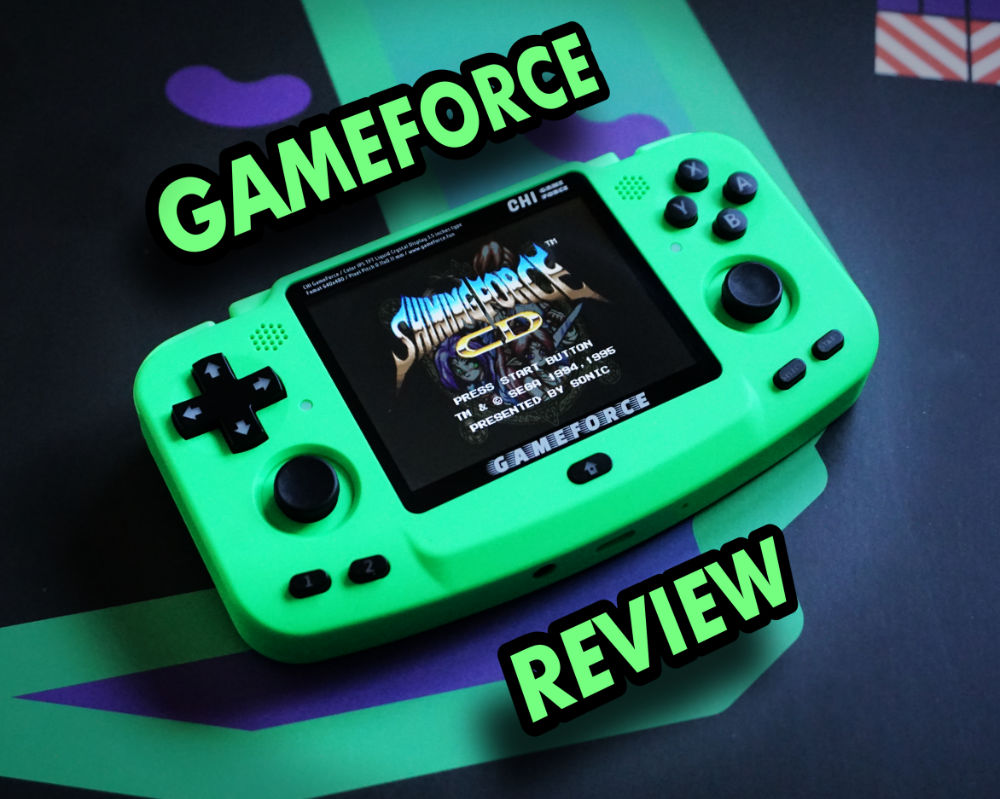

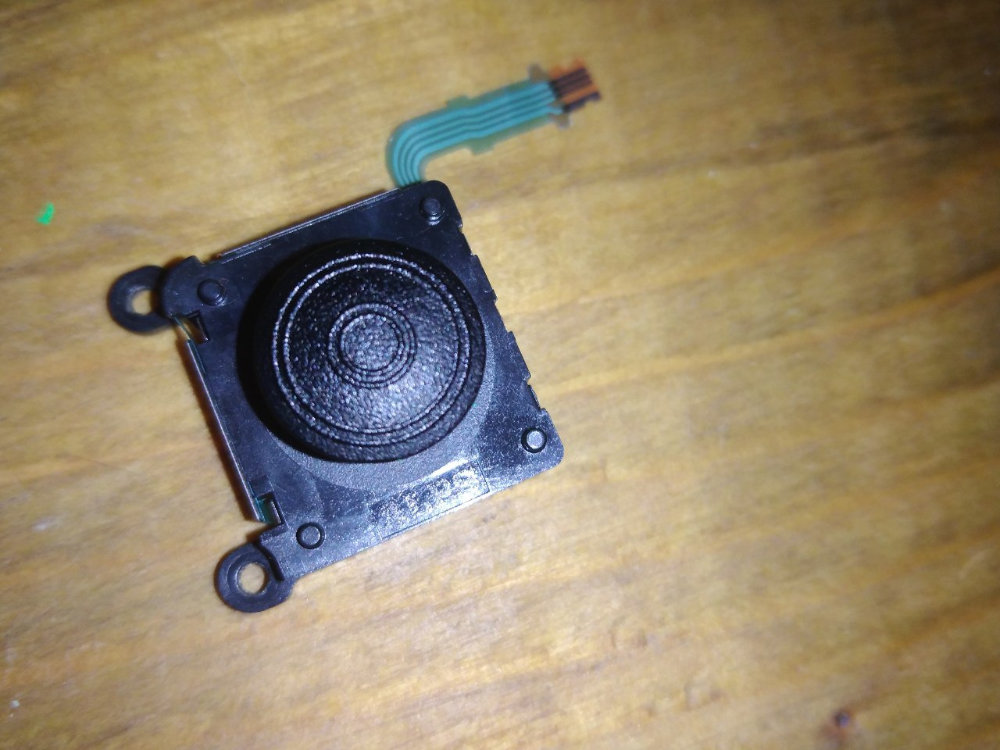
I would like to leave a comment about the quality of the Anbernic and GPD devices compared to GameForce.
We get (we are from DroiX) issues with Anbernic devices, mostly batteries, joysticks, screens or buttons. And compared to GameForce Anbernic has much lower quality of the components used on the device.
GameForce uses ALPS joysticks, same as were used on the GPD Win, Win 2, GPD XD Plus and Anbernic has cheap ones. We, as a retailer for these gaming consoles think GameForce is the better than Anbernic, however can’t disagree on the design part. It’s not for everyone 🙂
Thanks for the insight Eugene
I have received my unit a few days ago. It is great fun. I love the unique design. No problems with ABXY
Great to hear that
The screen is tempting, but I already bought RG351v for the year. Perhaps as a gift for my nephew later in the year, I don’t know.
Happy to see they gave you a unit, you definitely deserve it considering the service you provide to this community.
All the best, thanks for another awesome review
Pros:
– unique build (kind of a mash-up between NGPC and GBA)
– vibrant colors available
Cons:
– one-man vision? Naaah, too many bad implications
– another RK3226 at this time of the year? Nooope
– besides the cool build, anything else looks really cheap (buttons for instance)
while I appreciate Mr. Gao work on its own, definitely an easy pass on this one
To improve:
– New color: Indigo / purple + Gray (like GBA)
– L1/2, R1/2 triggers: stacked (like N Switch) instead of side by side
– Dual external TF input for SD cards (One for the Operating system and one for the roms) as did Anbernic on the RG351V (that reduces the risk of touching unknown system settings)
– If possible, a larger battery or at least a fast charge, 4 hours of play seems little
A great review, thank you.
The mushy, tall ABXY you describe, combined with no option for silver like the earlier pics we saw, will really make sure I stop myself from buying… Ah well, good for my wallet 😀
Can’t wait for the more powerful chips / Cm4 handhelds!